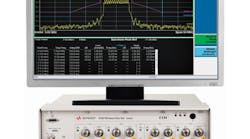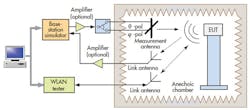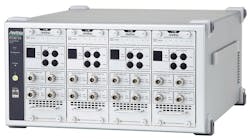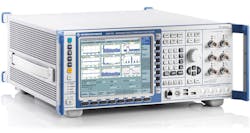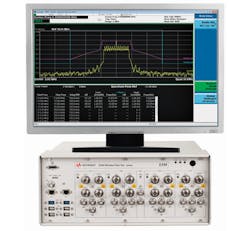This file type includes high resolution graphics and schematics when applicable.
An interconnected wireless world with myriad multifunctional sensors and processing devices is already a reality. A common modern environment isn’t complete without its own ecosystem of smartphones, tablets, cameras, RF identification tags, wearable devices, and sensors—all connected through several public and private wireless standards. The wireless technologies enabling the Internet of Things (IoT) and Machine-to-Machine (M2M) devices have customized requirements and performance criteria for each application. In turn, devices based on these wireless technologies must be characterized, compliance-tested, and checked for quality before reaching an end-user. This level of testing requires highly flexible and customizable test systems that can facilitate automation and cost-effective upgrades.
Smartphones and cellular telephones drive a significant amount of communications-based data over several wireless standards and protocols. The most-common standards, such as CDMA, GSM, UMTS, and LTE, are spread across frequencies owned by wireless service providers. Third- and fourth-generation (3G/4G) Long-Term-Evolution (LTE) wireless technology drives the majority of cellular data traffic, and covers the widest range of frequencies. LTE is also undergoing advancements that will enable greater data rates, by using multiple LTE channels for a data stream and implementing receiver diversity. With in-building distributed antenna systems (DASs), cellular telecommunication activity is no longer limited to wide open spaces. Unfortunately, signals in these systems tend to suffer from multipath issues and deployment challenges in urban environments or linear internal spaces.
As data demands from cellular telephone users exceed cellular system capacities, a significant amount of data traffic is being offloaded to Wi-Fi systems. Wi-Fi is the most trafficked wireless solution, with Frost & Sullivan estimating that over 55% of all mobile data will be offloaded to Wi-Fi by 2017. This strain on Wi-Fi has also encouraged the Wi-Fi Alliance to enhance its legacy standards with updated standards and frequencies that better facilitate modern wireless communications. This led to the development of IEEE 802.11ac, a 5-GHz ISM-band Wi-Fi solution with carrier aggregation (CA) and multiple-input, multiple-output (MIMO) protocols within the standard.
Future standards—IEEE 802.11ah and IEEE 802.11af—will incorporate many of these new protocols in the sub-1-GHz and television-white-space frequency ranges. These new advances put very wide bandwidths of Wi-Fi channels in close proximity to cellular communications with channels that are within potential interference ranges. Other standards, such as ZigBee, Thread, and Bluetooth, also operate in close proximity. The 2.5- and 5-GHz ISM bands are also open to other RF applications, which lead to a cluttered spectrum for high-speed, reliable telecommunications.
Hundreds of millions of portable wireless products employ a wide range of these wireless standards. These products often carry multiple radios that operate from frequencies as low as the 13.56 MHz used in near-field communications (NFC) applications to 5.8 GHz Wi-Fi. The density of radios in a single portable electronic product makes power efficiency, coexistence, and spectrum management significant concerns. Moreover, public safety and military forces have begun adopting commercial wireless connectivity solutions with enhanced security and robustness. These factors leave the designers of this equipment with a battery of compliance and qualification testing from the prototype stage to field-deployments.
HetNet Tech
Adding to the complexity of current portable wireless operation is the recent advance of heterogeneous network technologies. An example of this is carriers developing seamless merging of cellular and Wi-Fi data connections to enhance user experience and support Wi-Fi assuming large amounts of cellular backhaul (Fig. 1). Wi-Fi mobile converged devices will have the capability to hand off from cellular data to Wi-Fi systems in areas where signals are strong enough to sustain a suitable data rate. Since the throughput of a Wi-Fi connection is sensitive to external interference, testing these devices for radio frequency interference (RFI) during a handoff requires additional device testing (Fig. 2).
The number of tests for a highly connected device is at such a high level that automated testing is the only feasible solution to determine the compliance and qualification of each device within a reasonable time (Fig. 3). A challenge for test-and-measurement instrument designers is that these test cases continue to advance and change faster than a testing device could be designed, built, and shipped. Many test and measurement companies—Rohde & Schwarz, Keysight Technologies, Anritsu Corp., National Instruments, and Litepoint, for example—offer highly customizable wideband testing platforms operating to 6 GHz with 160 MHz to 200 MHz of instantaneous bandwidth. The wide bandwidths are necessary for testing CA-based IEEE 802.11ac- and 4G-LTE-enabled devices and products (Fig. 4).
Even with the shift to non-signaling test systems for portable wireless devices, the number and complexity of wireless standards increases the test time per device. The time a device spends in the test bed directly relates to the costs of test, which in turn drives up device prices. These factors have created an extremely competitive automated test market, where manufacturers have to be confident that the expenses in their test facilities minimally impact overall device prices.
Test-and-measurement companies now provide modular wireless test instruments that support a variety of radio test functions (Fig. 5). These modular solutions are computer controlled for enhanced autonomy, and individual instrument cards can be exchanged for rapid maintenance or upgrade. Each of the four modules is a complete transceiver tester independently programmed and controlled. This configurability enables a single chassis to either test several wireless standards in rapid succession or for each module designated to perform radio tests on a single device in parallel.
The majority of these devices are controlled through remote terminals that employ automation software suites with built-in/optional analysis tools. These software tools are often upgradable at cost to the latest wireless standards and analysis methods. Some of these testers incorporate card-key or digital-key unlockers that enable different modulation analysis tools, which enable a multiple-instrument owner to swap analysis capability to the devices that require it without having to purchase redundant licenses.
Over-the-air (OTA) updates for these boxes could rapidly increase a test facility’s ability to incorporate new wireless standards in its testing protocols. Embracing the need for highly flexible tester use, National Instruments’ Wireless Test System incorporates an on-board field-programmable gate array (FPGA) and is capable of advanced signal processing features (Fig. 6). The on-board FPGA architecture has the potential to increase the speed of tests with advanced digital modulations, as modern FPGAs can contain nearly 2 million logic cells and over 5,000 giga-multiple-accumulate applications per second (GMACS) of peak digital-signal-processing (DSP) performance. This and greater processing capability will be required for future wireless standards that are incorporating higher-level digital modulation capabilities to increase spectral efficiency for enhanced data rates.
This file type includes high resolution graphics and schematics when applicable.
The IEEE 802.11ax Standard
This file type includes high resolution graphics and schematics when applicable.
An example of a wireless standard geared toward maximizing data rate performance using MIMO and CA is IEEE 802.11ax. Where IEEE 802.11ac’s maximum speed is 1.3 Gb/s, IEEE 802.11ax is designed to reach over 10 Gb/s—actively competing with wired data-transfer standards, such as Universal Serial Bus (USB) 3.1. In an experimental test, Huawei reportedly achieved 10.53 Gb/s, or 1.4-GB, data transfer speeds.
To reach these speeds, IEEE 802.11ax uses 4 × 4 MIMO and orthogonal-frequency-division-access (OFDA) technology for each multiplexed data stream. Each stream of IEEE 802.11ax is designed for rates to 3.5 Gb/s, which is about four times the streaming speed of IEEE 802.11ac. The 802.11ax system occupies the same 5-GHz frequency range as IEEE 802.11ac.
The 802.11ax and other future wireless standards that are designed to handle the latest data demands will require greater processing power. Wireless testers could rely more on high-powered FPGAs to increase the testing rates and ability to handle complex digital modulation, such as 256-state quadrature-amplitude-multiple (QAM256) formats. Test protocols will also continue to advance to accommodate the volume of wireless standards in security, defense, and M2M applications. This burden will fall on testing facilities to expand their capabilities to test interference and compliance.
For example, ETS-Lindgren in Malaga, Spain, recently announced the opening of a MIMO OTA test and measurement laboratory at AT4 Wireless test facilities. The fully anechoic-lined chamber has an array ring of 16 antennas and is designed to test single- and multiple-cluster environments. Multipath and radiated environment testing for portable wireless and cellular device can be placed in simulated real-world scenarios, more accurately depicting modern RF environments.
The theme of most modern test systems has now become the capability to adapt to new testing scenarios through modularity, reprogrammability, PC control, or hardware abstraction. These trends may be a direct result of the increased flexibility of modern radio equipment. With software-defined-radio (SDR) structures increasingly being used for wireless technologies, test equipment must become more agile to confirm the operation of a device under test (DUT) with a virtually infinite number of operating modes.
In addition, the increasing occupation of frequency spectrum has continued to inspire concepts for implementing fully cognitive radio-based spectrum allocation. In such concepts, radios themselves would have the intelligence to assess their present RF environment and decide the best tactics for optimum performance. The years ahead should continue this trend of the test-and-measurement industry needing to respond quickly to changing communications markets, notably as 5G cellular and millimeter-wave-frequency communications systems become realities.
Resources
Authorized Independent Wi-Fi Alliance Test Laboratories
CTIA Test Plan for RF Performance Evaluation of Wi-Fi Mobile Converged Devices
This file type includes high resolution graphics and schematics when applicable.
